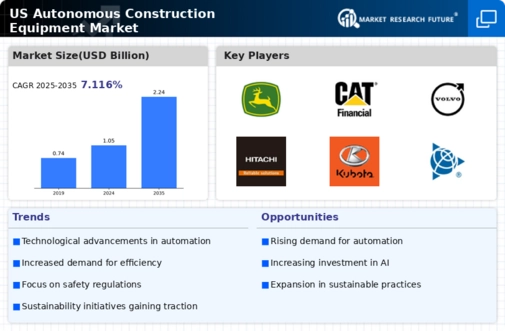Increased Labor Costs
The rising costs associated with labor in the construction sector are driving the adoption of the autonomous construction-equipment market. As labor expenses continue to escalate, companies are seeking innovative solutions to mitigate these costs. Autonomous equipment can operate without the need for constant human oversight, potentially reducing labor requirements by up to 30%. This shift not only helps in managing operational costs but also addresses the challenge of labor shortages in the industry. The autonomous construction-equipment market thus presents a viable alternative for companies aiming to maintain productivity while controlling expenses. Furthermore, the ability to operate in hazardous environments without human intervention enhances safety and efficiency, making this market increasingly attractive to construction firms. As labor costs are projected to rise further, the demand for autonomous solutions is likely to increase, positioning the market for substantial growth.
Technological Integration
The integration of advanced technologies such as artificial intelligence (AI), machine learning, and the Internet of Things (IoT) is a key driver for the autonomous construction-equipment market. These technologies enable equipment to perform complex tasks with precision and efficiency, thereby enhancing overall productivity. For instance, AI algorithms can analyze vast amounts of data to optimize equipment performance and predict maintenance needs, reducing downtime. The market is witnessing a surge in investments in R&D, with companies allocating approximately $1 billion annually to develop smarter and more efficient autonomous systems. This technological evolution not only streamlines operations but also improves safety by minimizing human error. As construction projects become more complex, the demand for sophisticated autonomous solutions is expected to grow, further propelling the market forward. The ongoing advancements in technology are likely to redefine operational standards within the industry.
Safety and Risk Management
The emphasis on safety and risk management on construction sites is a crucial driver for the autonomous construction-equipment market. With construction being one of the most hazardous industries, the integration of autonomous equipment can significantly reduce the risk of accidents. Autonomous machines can operate in dangerous conditions, minimizing human exposure to potential hazards. Reports indicate that the use of autonomous equipment can lead to a reduction in workplace injuries by up to 40%. This focus on safety not only protects workers but also enhances overall project efficiency. As companies prioritize safety protocols, the demand for autonomous solutions is likely to increase, positioning the market as a key player in promoting safer construction practices. The ongoing commitment to improving safety standards will likely drive further investment in autonomous technologies, which will foster market growth.
Infrastructure Development Initiatives
Government initiatives aimed at enhancing infrastructure development are significantly impacting the autonomous construction-equipment market. With the U.S. government committing over $1 trillion to infrastructure projects, there is a heightened demand for efficient construction solutions. Autonomous equipment can expedite project timelines and improve accuracy, making it an attractive option for contractors. The market is poised to benefit from this influx of funding, as construction firms seek to leverage autonomous technologies to meet project deadlines and budget constraints. Additionally, the push for modernizing aging infrastructure creates opportunities for innovative equipment that can operate in diverse environments. As these initiatives unfold, the autonomous construction-equipment market is likely to see increased adoption, driven by the need for efficiency and effectiveness in large-scale projects. This trend suggests a robust growth trajectory for the market in the coming years.
Environmental Regulations and Sustainability
The growing emphasis on environmental regulations and sustainability is influencing the autonomous construction-equipment market. As construction firms face increasing pressure to reduce their carbon footprint, autonomous equipment offers a pathway to more sustainable practices. These machines are often designed to operate more efficiently, consuming less fuel and generating fewer emissions compared to traditional equipment. The market is witnessing a shift towards electric and hybrid autonomous vehicles, which align with regulatory requirements aimed at reducing environmental impact. Furthermore, the potential for autonomous equipment to optimize resource usage contributes to waste reduction on construction sites. As sustainability becomes a core focus for the industry, the demand for environmentally friendly autonomous solutions is expected to rise, driving growth in the market. This trend indicates a significant alignment between regulatory frameworks and market opportunities.

















Leave a Comment